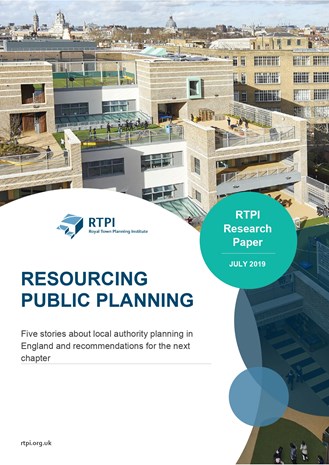 This page refers to research and recommendations relating to local planning authorities in England. RTPI Scotland has also published a related analysis for Scotland.
This page refers to research and recommendations relating to local planning authorities in England. RTPI Scotland has also published a related analysis for Scotland.
This project explores the current level of resourcing of planning and aims to establish what level of resourcing might deliver the places and homes we need. The report is based on exploring the implications of five stories that emerge from analysis of data on planning in local authorities.
First, we find that total expenditure on planning by local planning authorities is now just £900 million a year across England. More than half of this is recouped in income (mostly fees), meaning that the total net investment in planning is now just £400 million, or £1.2 million per local authority.
Second, we show how reductions in budgets have forced local planning authorities to focus on development management and income generation, whilst proactive policymaking has lost out.
Third, we show that public planning is increasingly reliant on income from development management, which now accounts for about half of all spending on planning.
Fourth, we examine the staggering regional imbalance in funding for planning, finding that the average investment in planning of local authorities in some regions is three times more per inhabitant than in others.
The final story describes the shift towards more planners working in the private sector over the last decade. It questions whether this represents a fundamental reshaping of the profession and considers potential implications.
Finally, we make a case for investment in planning as a way of delivering against the objectives of central and local government.
Click here to download or read on below.
Contents
2. Five stories about public planning
- Story 1: English local authorities underinvest in planning and place
- Story 2: Cuts have focused local authorities on development whilst pro-active policymaking has declined.
- Story 3: The funding of public planning is increasingly privatised and this changes incentives
- Story 4: There is a huge regional imbalance in investment in place
- Story 5: The planning profession as a whole has had a major shift towards the private sector
3. Securing value from investment in placemaking
Executive summary
This paper explores how local authorities fund planning in England, focusing on five stories which emerge from local authority spending data. We consider the current level of resourcing of local planning authorities, point to the problems arising from reduced expenditure, and make a case for increased spending on planning as an efficient way of delivering social outcomes.
First, we find that total expenditure on planning by local planning authorities is now just £900 million a year across England. More than half of this is recouped in income (mostly fees), meaning that the total net investment in planning is now just £400 million, or £1.2 million per local authority. This is fifty times less than local authority spending on housing welfare, and twenty times less than estimates of the additional uplift in land values which could be captured for the public during development.
Second, we show how reductions in budgets have forced local planning authorities to focus on development management and income generation, whilst proactive policymaking has lost out. This has not only challenged local authorities’ ability to fulfil policy functions and provide certainty to developers, but has also made them a less attractive place to work, challenging their ability to recruit and retain staff.
Third, we show that public planning is increasingly reliant on income from development management, which now accounts for about half of all spending on planning. This is largely an intentional result of plans from central government and local authorities to reduce public spending. However, we consider some of the risks that come with this focus on income and the incentives which come with it.
Fourth, we examine the staggering regional imbalance in funding for planning, finding that the average investment in planning of local authorities in some regions is three times more per inhabitant than in others. This scale of disparity will surely challenge attempts to rebalance the economy.
The final story describes the shift towards more planners working in the private sector over the last decade. It questions whether this represents a fundamental reshaping of the profession and considers potential implications. Finally, we make a case for investment in planning as a way of delivering against the objectives of central and local government. We propose significantly increased resourcing to deliver better development management, strong and informed planning policy, genuine community participation, pro-active local authority-led development and a wider range of built environment professionals in the public sector. To secure this we propose doubling investment in planning in England as well as other solutions including training and apprenticeships. We argue that with more resourcing and powers planning can help tackle the most important issues on the horizon.
1. Introduction
In this report we tell five stories that are crucial to understanding local authority planning and placemaking in England. These stories will be largely familiar to those working in local authorities who see them acted out in practice. However, it is important that everyone understands them, including decision-makers in particular. The report also provides quantitative evidence to demonstrate the operation and scale of these issues.
An underlying theme is the lack of investment in place and its implications. This underinvestment is linked to the failure to solve issues as diverse as spatial economic imbalance, the housing crisis, climate change, deprivation, public health, and an ageing population. We provide evidence on the scale of under-investment and suggestions of how to maximise the value of planning and of public investment in place.
Methodology
Most of the figures in this report are based on our analysis of Ministry for Housing, Communities and Local Government (MHCLG) data on Local authority revenue expenditure and financing.[1] This data shows local authority spending on various services back to 2007-08. We focused in particular on spending in 2017-18, and comparing it to 2009-10 (adjusting to 2017-18 prices using the GDP deflator).[2] We also drew on Office for National Statistics (ONS) data on population size and density in mid-2017.[3]
For this paper we have taken the same approach as the National Audit Office (NAO) in ‘Planning for New Homes’[4] – that is, focusing on spend on ‘development control’, ‘conservation and heritage policy’, and ‘other planning policy’. However we have focused on change since 2009-10 rather than 2010-11, and we have also focused on a different set of authorities – excluding non-unitary counties and the Greater London Authority in order to focus on only conventional local planning authorities and National Park Authorities (335 in total). It is worth noting that the planning authorities we did not include have experienced, on average, larger reductions in spending than the authorities we focus on here.
Finally, we drew on analysis from other recent RTPI research on ‘The Planning Profession in 2019’[5], in particular to make estimates of the size of planning teams in Story 2. This research used RTPI Member Survey and Membership statistics, along with labour force statistics from the Office for National Statistics and EUROSTAT.
2. Five stories about public planning
Story 1: English local authorities underinvest in planning and place
Local authorities spend just under £900 million a year on planning. Over half of this is recouped in planning fees and other income, so the net investment by local authorities in planning in 2017-18 was actually only around £400 million. This works out to just £1.2 million per local planning authority per year, or about £7 per person a year (see Figure 1).
The amount invested by local authorities in planning reduced by 42% since 2009-10 in real terms (see Figure 1). However, even in 2009-10 the resource dedicated to planning was low compared to some countries celebrated for their planning and urban form. There are around 22,000 planners in the UK, or around one planner for every 3000 persons. By contrast, the Netherlands, which is known for excellent planning, has one planner per 1100 persons.[6]
Figure 1: Mean Total and Net expenditure per local planning authority
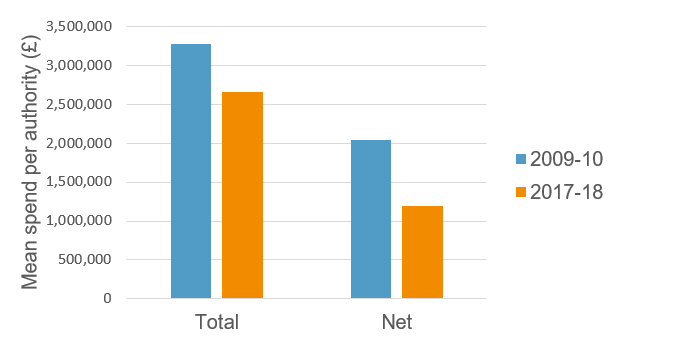
Source: RTPI analysis of MHCLG data on Local authority revenue expenditure and financing. 2009-10 values adjusted to 2017-18 prices using GDP deflator.
Only a small fraction of local government budgets are allocated to planning (£401 million or 0.5% of net spending in 2017-18). This is down in both absolute and relative terms since 2009-10 (from £686 million or 0.6% of net spending).
About two-thirds of total reductions to spending on planning have been reductions in spending on planning policy (see Figure 2). This is discussed further in Story 2.
Figure 2: Breakdown of reductions in total expenditure on planning between 2009-10 and 2017-18
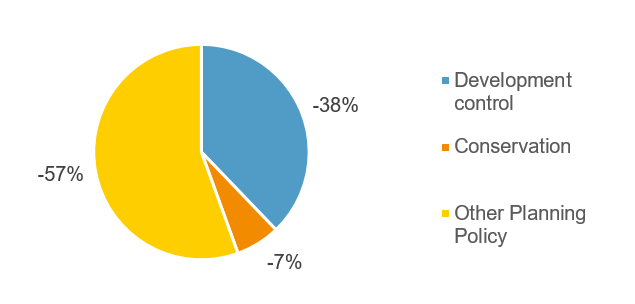
Source: RTPI analysis of MHCLG data on Local authority revenue expenditure and financing.
Spending on planning is eclipsed by other parts of local authority spending, and in some cases better resourced planning might even be able to bring these costs down. For example, at £20 billion per year in 2017-18, local authorities net spend on housing benefit is almost fifty times the net spend on planning. Moreover, a properly resourced planning system would be in a better position to help secure new affordable and social housing which could bring this bill down. Spending on planning also pales in comparison to estimates of the additional amount of land value uplift which could be captured by local authorities during development (£9.3bn according to an estimate by the Centre for Progressive Policy). Greater investment in planning could help secure more of this uplift for the public.
Finally, planners are not the only profession that contribute to creating great places and it is not just planners that suffer from under-resourcing of placemaking in local authorities. Even by 2012, only a third of local authorities had in-house ecologists and were struggling to meet their statutory obligations.[7] Now Biodiversity Net Gain will bring new obligations. In addition, although there are many more architects than planners overall, there are very few architects in the public sector. As recently as the 1970s the public sector employed half of all architects. Now it is about 3%. Several other professionals like landscape architects and community organisers are also under-supplied in the public sector.
Why has this happened?
The simplest answer is a lack of resourcing for local authorities. Especially since 2010, local authorities have had to make hard decisions about what to fund. With growing responsibilities, especially for social care, other services will inevitably lose out. However, even prior to 2010 planning was arguably not well resourced.
Another reason public planning is resourced poorly is that it is predominantly aimed at representing the public interest in development rather than primarily promoting development or securing profit. Our research on the Value of Planning has clearly demonstrate the major, varied economic benefits associated with planning. However these benefits generally accrue to the public rather than to individuals. With such a diverse set of benefits, distributed so diffusely, there is essentially no constituency who experience sufficient tangible benefits to call for its expansion. Meanwhile the costs accrue to a relatively small number of individuals with a disproportionate amount of economic and political power.
What are the implications?
The implications of this lack of resourcing are a consistent theme throughout this report. They can broadly be divided into three categories (1) insufficient funding to deliver normal services; and (2) lack of investment in place-based solutions to wider social issues; and (3) challenges to local planning authorities and civic planning more generally.
The first category covers what are generally considered to be the core activities of local planning authorities – development management and planning policy. In short, lack of funding means less resources being dedicated to each application that comes through planning, and less proactive planning. Another direct impact of this is on communities. If a high number of decisions are made with less resource committed to each, the main loser may be local communities who will be living with development which has had less scrutiny. Lack of funding will also mean less time for securing community participation in plan-making.
The second category relates to the damage caused by giving insufficient attention to space-based solutions to social, economic and environmental issues. The RTPI has published a number of research papers on this, highlighting the importance of place based solutions for issues as broad as poverty and inequality[8], economic productivity, public health, climate change, the housing crisis, an ageing population.[9] If local authorities fail to invest in place-based professionals they will miss out on opportunities to address these issues.
The third category covers damage to the structures of public planning which can take many years to fix. The impact of cuts to planning is felt keenly by local planning officers, who both have to operate with less resources, and to deal with public dissatisfaction that can arise from this. This not only limits the ability of local authorities to shape places, but also makes a career in local authority planning less desirable. Short term impacts include difficulty recruiting and the negative impacts of ‘churn’, or rapid staff turnover. However, if local authorities doubled funding for planning tomorrow this would not immediately fix the damage that has been done by years of underfunding. Major loss of subject and institutional expertise and a shortage in the supply of new planners will take years to address.
Story 2: Cuts have focused local authorities on development whilst pro-active policymaking has declined.
It is crucial to understand how cuts are reshaping local planning authorities – in particular by forcing them to prioritise meeting statutory obligations around development management over engaging in strategic policymaking and proactive planning.
At £279 million, total spending on planning policy made up less than a third of English local planning authorities’ spending on planning in 2017-18, having been cut by a third since 2009-10. This spend needs to cover all the policy making functions of the local planning authority, from developing a local plan (including the evidence base) to producing all supplementary guidance, and informing colleagues about new Government policy. Total spend on all of this was much less than a million pounds per local authority, or £5 per person per year. Figure 3 shows that 73% of all reductions in spending on staff fell on planning policy.
Figure 3: Real-terms reductions in expenditure on planning staff in local authorities between 2009-10 and 2017-18
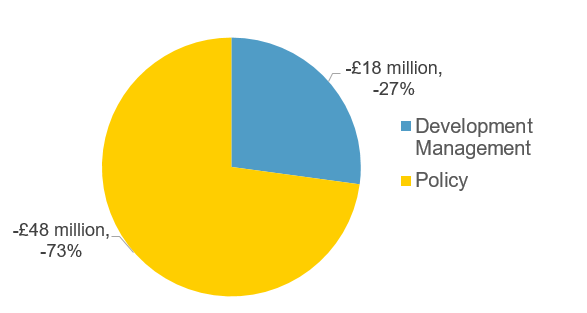
Source: RTPI analysis of MHCLG data on Local authority revenue expenditure and financing.
This has resulted in a local authority planning sector which is more and more dominated by development management. We estimate that over a thousand policy planners were lost from local authorities between 2009-10 and 2017-18.[10] Figure 4 provides an estimate of how the average local planning authority changed between 2009-10 and 2017-18. It is worth emphasising that this will vary greatly between authorities and the median team is likely to be smaller than this.
Figure 4: Average make up of local authority planning teams in England
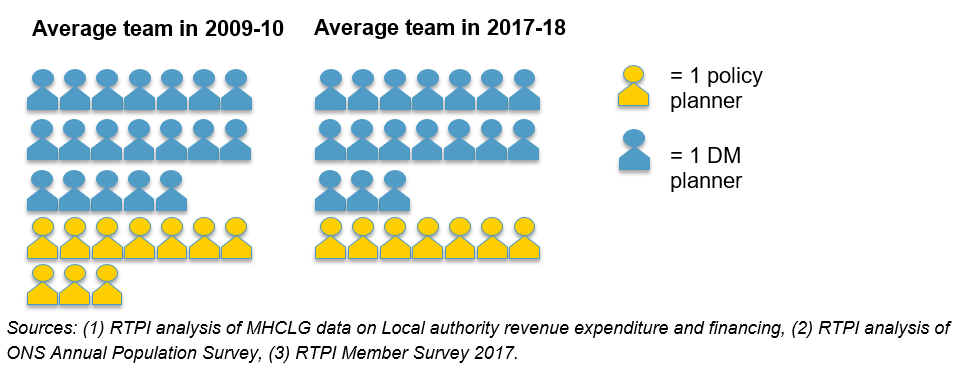
Finally, this huge cut in resources for planning policy has come at a time of especially high workload for policy officers. A 2016 RTPI survey suggested 73% of planners felt this constant change to national policy had hindered their ability to deliver good places.
Why has this happened?
To a large degree this is an entirely predictable reaction to reduced budgets. As has been found across local government it represents a shift towards focusing on statutory services at the expense of other services. This also reflects findings in our previous research on Investing in Delivery[11], on the experiences of planners in the North East and South East.
However, income also plays a major role in the rebalancing towards development management, as discussed in Story 3. While reductions in core funding for development management could be made up by increased income, the same was not true for planning policy, indeed income from policy fell substantially.[12] Perhaps inevitably, local authorities prioritise the activities which generate income over those which do not.
What are the implications?
Cuts to planning policy have made it difficult for local authorities to deliver strong up-to-date Local Plans and other policy and guidance. Ultimately this will lead to less certainty for developers, less strategic spatial solutions to social issues, and worse place outcomes.
The increased focus on development management and income generation has also made local authorities a less attractive place to work, challenging their ability to recruit and retain staff and ultimately to function properly. Recent research found that “a ‘box ticking’ culture… has closed down a lot of the space planners traditionally had for reflection, professional discretion, and proactive planning.”[13]
Story 3: The funding of public planning is increasingly privatised and this changes incentives
In addition to the overall reduction in spending on planning and the decline in the relative position of planning policy, Figure 5 highlights two other major changes to how local authorities deliver planning services, focusing on how public planning is funded:
First, a relatively small decline in total spend on development management between 2009-10 and 2017-18 (-11%) hides a far larger reduction in the amount local authorities spend on subsidising the cost of development management (-54% or -£221 million less in real terms). Subsidy is needed since planning fees do not fully cover the management of applications. This 54% decline in the subsidy for development management was actually the single biggest reduction in core funding of planning in absolute terms.
Second, income from development management is now far more important to the funding of planning departments. In 2009-10 income from development management was equivalent to about a quarter (26%) of total spending on planning. By 2017-18 income from development management was greater than core funding for planning, and equivalent to about half (48%) of all spending on planning. It will likely have risen to more than half in 2018-19 given the fee increase.
Figure 5: Spending from core funds and planning income (equivalent to total spending)
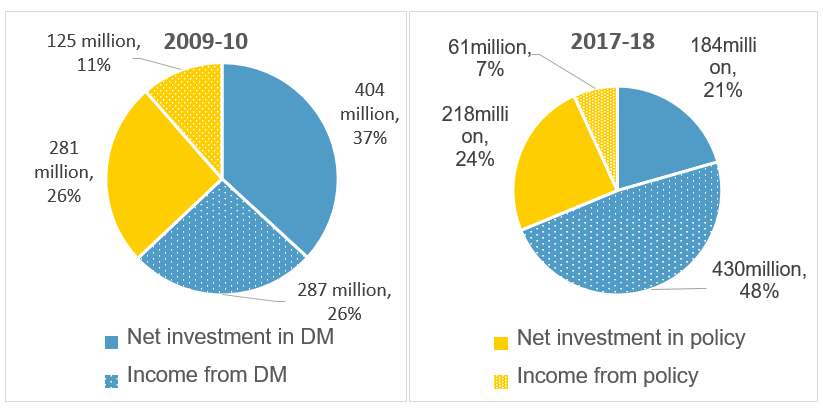
Source: RTPI analysis of MHCLG data on Local authority revenue expenditure and financing. 2009-10 values adjusted to 2017-18 prices using GDP deflator.
In 2017-18 local authorities raised 50% more in income from development management than in 2009-10. This came from two major sources:
- Increased planning fees. Fees rose by 15% in 2012 and an additional 20% in 2018 (suggesting income should be even higher in 2018-19). We estimate over £100million more was raised from fees in 2017-18 compared to 2009-10.
- A rise in paid for services like pre-application consultations and planning performance agreements. We estimate income from these was around £50million in 2017-18. It is unclear how much more this is than in 2009-10 however findings from our research on Investing in Delivery[14] suggests a significant increase.
Why has this happened?
The shift towards funding planning from development management income is a successful result of central and local government ambitions to reduce public spending. Local authorities now dedicate much less core funding to planning services and increased income has meant relatively small declines in total spending on development management. One could also argue that cuts on planning policy might have been more severe had income from development management not increased so much. Since planning fees are a very small proportion of total development costs, it can be argued that shifting this cost on to developers is an effective way to save public money without disincentivising development.
This shift is also related to the increasing privatisation and marketization of public services. In this framing, the shift towards private funding of planning is related to a shift from viewing the planning system as a way of delivering social outcomes to a way of facilitating development.
What are the implications?
In addition to the relative lack of resource dedicated to planning policy, a core implication of this shift in funding is a move away from the idea of planning as a public service aimed at achieving public outcomes. If planning is funded not through public investment, but rather through private fees, this will almost certainly have an impact on how it is delivered.
Given acute funding pressures, it is important that local planning authorities will now see the only realistic way of raising additional funding as being to encourage new development. Again, this is not necessarily unintentional, or a bad thing. However, it may mean less resource dedicated to scrutiny of the impacts of new development and how to mediate them.
There is also a real risk that increased reliance on fees from applications, pre-application consultation, and planning performance agreements will lead to a two-tier planning system, where those who can afford to pay get a better service than those who can’t. Or even in the extreme where engagement with planning is limited to those with significant resources.
RTPI is a partner in ongoing research on ‘Working in the Public Interest’, which is further exploring these implications. [15] The first report from this project, ‘Serving the Public Interest’, explores outcomes from the reorganisation of public planning since 2010. These included “reluctant outsourcing”, “strategies orientated to being pro-development and lean”, “proceduralism”, “shortage of senior public sector planning officers”, and planners making less distinction between public and private sectors.[16]
Story 4: There is a huge regional imbalance in investment in place
To truly understand the problems facing placemaking in the UK it’s crucial to understand the huge differences in resourcing around England. Regional imbalance was already present in 2009-10, but by 2017-18 the differences were stark. In 2017-18 total spending on planning per person living in the South East and East of England was double the spending per person in each of the regions in the North of England or the West Midlands.
Moreover the main reason for this isn’t the Southern regions being better able to attract income from development management. If we look at net spending (i.e. spending minus income), the difference is even more stark (see Figure 6). By 2017-18 local authorities in the South East were investing more than triple the amount per person than those in the North West, West Midlands, or the North East.
Figure 6: Annual net expenditure per person on planning in each region
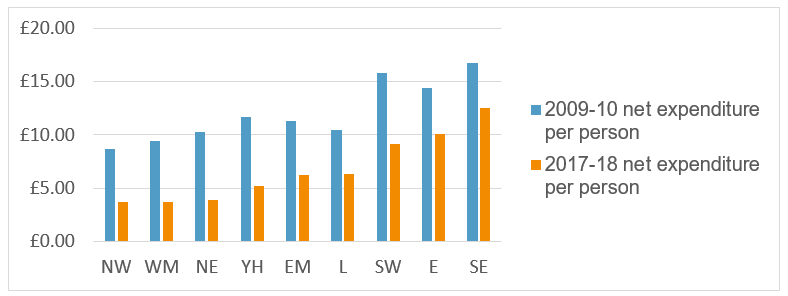
Source: RTPI analysis of MHCLG data on Local authority revenue expenditure and financing.
Not all regions have seen major increases in income from development management. Whilst London, the South East, and the North East each increased planning income by over two thirds between 2009-10 and 2017-18, the equivalent rise in Yorkshire and the North West is under a fifth. Meanwhile some regions have almost entirely removed subsidy for development management whilst others subsidise the cost by up to 43% (see Figure 7).
Figure 7: 2017-18 local authority spending on development management per person
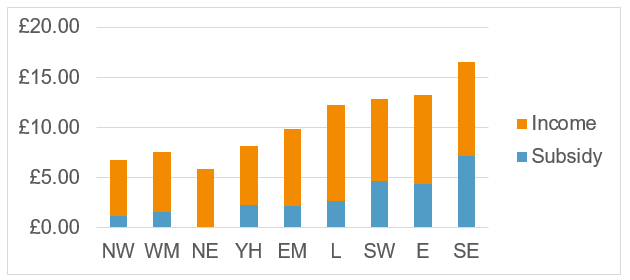
Source: RTPI analysis of MHCLG data on Local authority revenue expenditure and financing.
Finally, the same trend is visible in spend on planning policy (see Figure 8). Whilst the national average in England is for about £5 per person to be spend on planning policy, this falls to around £3 in the North West, West Midlands, and Yorkshire.
Figure 8: Planning policy expenditure per person in each region
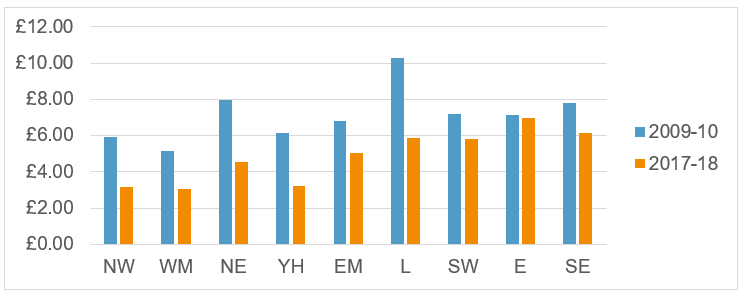
Source: RTPI analysis of MHCLG data on Local authority revenue expenditure and financing. 2009-10 values adjusted to 2017-18 prices using GDP deflator.
Why has this happened?
To a large degree this reflects the situation of English local government more generally.[17] Local authorities who were poorer to start with and are least able to raise additional council tax have to make steeper cuts. These cuts in turn reduce economic demand in the areas, further exacerbating the problem. Steeper reductions in funding mean non-statutory services decline.
What are the implications?
It is worth dwelling on the implications of these findings. They show that the regions who struggle to attract new development are actually spending substantially less on subsidising it. Likewise they are investing less in pro-active policy which will help attract it. It will surely be impossible to address regional imbalances given such a situation.
How can we possibly expect to rebalance the economy spatially, when local authorities are investing far more in the areas which already have more development?
Story 5: The planning profession as a whole has had a major shift towards the private sector
A shift of planners from the public to private sector has seen far less planners working in the former. Recent RTPI research[18] drawing on Office for National Statistics (ONS) figures, estimated there are 22,000 planners in the UK. It also found that this period has also seen a major shift in where planners are employed. Until 2010 the public sector employed about 70% of all planners in the UK, however it is now around 55%. This indicates a likely drop of about 21% in the number of planners working in the public sector (see Figure 9).[19]
Figure 9: Proportion of planners in public and private sectors over time
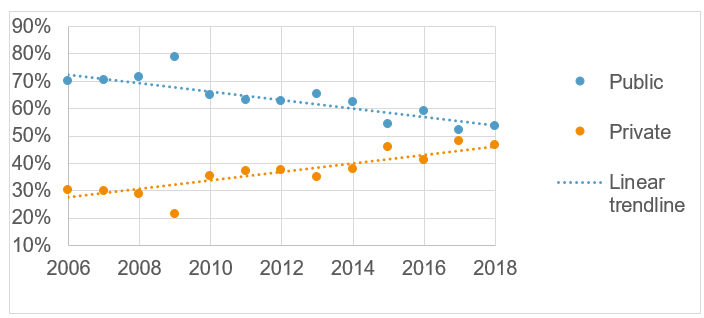
Source: ONS Annual Population Survey, filtered by SOC10M = 2432 (Town Planning Officers). Result for each year is based on period ending September that year.
Why has this happened?
This shift is likely to be a direct result of public spending cuts and many of the associated problems for local planning authorities discussed above. Local authorities will both lose the ability to fund the same amount of positions, and struggle to recruit to fill the ones they do have.
What are the implications?
If this trend continues it could mean a fundamental reshaping of the profession. While half of architects used to work in the public sector the number is now closer to 3%. Many local authorities already outsource portions of both development management and policymaking. The London Borough of Barnet has already entirely outsourced its development management to Capita. Recent research has highlighted some of the potential issues with this shift[20], however, ultimately we cannot know the full range of implications.
3. Securing value from investment in placemaking
We need to look beyond patching up the holes that have been created by recent cuts, to see public funding of planning as an investment in delivering the land use we need to deliver the social, environmental and economic outcomes we aspire to. To deliver this we will more resources for planning, and broad new investment in place to bring in more place-based professionals across the board. In this chapter we suggest some ways in which additional resources might be directed, and estimate how much each would cost to give an idea of the scale of ambition needed.
How to secure the value of planning
Planning can be an efficient way of using public investment to deliver social, economic and environmental value. Rather than look at planning as a way of facilitating development as cheaply as possible we need to explore what the optimum level of support is to achieve a broad range of outcomes in an efficient way.
Furthermore there is an obvious financial case for local authorities investing in planning. Planning fees and other income from development management are just a small part of the story. Planning and placemaking can also raise income by developing new industrial and employment space, which comes with increased business rates. It can make a place more attractive to visit which brings income to the local economy. And it can help provide new homes in places people want to live, which brings in more council tax.
However, in the absence of local government finance reform it may be difficult for local authorities to increase investment in planning, even if it will bring returns in the medium-term. Therefore we anticipate that central Government may also have to provide a significant amount of the new funding.
The rest of this section considers what level of resourcing might be needed to achieve various outcomes.
Responsive and thorough development management: They key goals of development management should be to provide a reliable, responsive service which attracts new development whilst properly scrutinising and improving it. This requires local authorities to have access to a broad range of professional skills, and the capacity to give each new development the resources it deserves. It also means proper resourcing for monitoring and enforcement to ensure delivery follows intention. We recommend:
- Return to pre-2010 levels of subsidy for development management would cost about £220 million a year across England. A more realistic target might be enough additional subsidy to get total spending up to the 2009-10 level (about £80 million).
- The setting of fees should be devolved, meaning each local authority can make a decision about how they fund development management in their area.
Plan-led development through strong, evidence-led up-to-date planning policy: Better-resourced local plans would help guide development according to the public interest and help tackle a broad range of issues. This would also provide certainty for developers. Resourcing should be sufficient to support a regular process of developing evidence for and updating local plans, as well as for rich community participation in the process. It must also leave spare capacity to deliver Supplementary Planning Guidance and other policy functions as required. We recommend:
- Local authorities should aim to return to pre-2010 levels of subsidy for planning policy – this would cost them £60 million across England, or about £180,000 each.
- Other parts of local authorities and other local funding bodies should also consider how increased investment in planning and place could help meet their wider aims. This might include local authority housing and public health teams, and Clinical Commissioning Groups (CCGs).
- If central government wants local authorities to help meet national targets it should consider how to incentivise them to deliver the requisite policy. This might draw on previous programmes such as the Housing and Planning Delivery Grant. This might include financial incentives for cooperation (e.g. over strategic green belt or waste management reviews), and for helping to deliver national targets (e.g. around housing numbers). If these incentives averaged to half a million pounds per local authority this would mean about £170 million in new funding across England.
Securing genuine community participation in plan making: Too often community participation is not resourced as a key part of the planning process. As with planning policy, rich community engagement can seem like an unaffordable and time consuming burden to overstretched local authorities. Benefits of greater resourcing for participation would include greater social cohesion, greater trust in government, and a closer link between communities and land use. We recommend:
- Central government should set up a fund to support community participation processes designed to inform plan making. The public participation charity Involve estimate that 2-day deliberative Citizens Juries cost about £15,000 per jury (12-24 people). If funding was made available for ten of these at the outset of every local plan process this would cost £150k per local authority per five years, which would average out to about £12 million across the country every year.
Encouraging regional rebalancing: Rather than focus on housing targets based on effective demand we should be considering where we want new development to go to meet social challenges. Aside from the need to address regional inequality, the planning system needs to ask questions like whether it is sensible to concentrate new development in the region of the UK at highest risk of water shortages given climate change.[21] We should give a particular focus to resourcing planning in areas where it is currently relatively under-resourced, and areas which struggled to attract development. We recommend:
- Central government should supply funding aimed at encouraging development in areas which struggle to invest in planning. This might include expanding existing devolution deals and develop new ones or it might be a general fund to which local authorities can apply. Bringing the average net investment per person in the lowest spending regions (North West, West Midlands, North East and Yorkshire) up to the average of the higher spending regions would cost around £100 million a year.
Investing in public placemaking more generally
Pro-active development: The National Audit Office evaluated the planning system on its ability to deliver 300,000 homes a year. But if local authorities are rely on the market to bring development forward, this is largely outside of their control. If the Government wants local authorities to play a key pro-active role in bringing forward new development this will need additional resourcing. We recommend:
- Local authorities should be provided access to funding and expertise to engage in pro-active development. In the medium-term, increased local authority-led development will create income for the council, however in the short term local authorities should be able to bid for funding to access new skills to deliver more housing, perhaps through Homes England.
Increasing access to place-based professionals across the board: Rather than looking at resourcing of planning, why not look at resourcing of placemaking. Is it really appropriate that only 3% of architects work in local authorities, or that some authorities don’t have access to ecological expertise? Our local authority housebuilding research has shown the large benefits from bringing in other professionals. As has Public Practice in London. Local authorities have a wide range of issues to deal with that have spatial implications, from climate change, to biodiversity loss, obesity and more. We recommend:
- Central Government should create a £100 million a year fund aimed at bringing a range of place-focused professionals into local authorities. This is equivalent to 20% of the money spent on planning staff each year. It could secure access to expertise from architects, surveyors, landscape architects, urban designers, ecologists, and other professionals who can help create great places.
What level of additional resourcing is needed?
If all of the above recommendations were carried out this would mean an additional £422 million a year investment in local authority planning in England each year. This would be equivalent to doubling the current net expenditure on planning. However, even with this additional investment the average net investment per authority would still only be less than £2.5 million a year. This is only intended to provide a rough idea of what could be achieved with additional funding. However, it points to the need to think big about investment in planning rather than just concentrating on small increases in fees.
Making local planning authorities work better
Increased investment in planning would go a long way towards improving the functioning of local planning authorities, however more will be needed to make local authorities an attractive place to work and help counter the shift to the private sector.
A key benefit of increasing resourcing would be to free up enough capacity to enable local authorities to release planners for training. At the moment many local authority planners struggle to get a day away from the office to take part in training sessions. This is especially important given it will be difficult to deliver a major increase in the number of local authority planners in the short term.
We also need to restore the corporate power of planning within local authorities. Our research on Chief Planning Officers has shown both how few English local authorities have a planner at the top table, and the wide range of benefits that can be achieved through having one there.[22] We should follow Scotland’s lead in legislating for mandatory Chief Planning Officers in every local authority.
New technology may also offer opportunities for improving the working lives of planners. RTPI is current working with the Connected Places Catapult to explore how technology can free up planners time to work on proactive planning.
Better resourcing, powers, and working practices could make local authorities an exciting place for planners to work. So many children grow up playing with Lego or with Sim City or City Skylines on their computer – they should know that planning provides a career with an opportunity to shape the places they live in and to contribute to the public good.
Work on the pipeline into planning
Encouraging the next generation of public planners is crucial to achieving great places. Planning is currently the third most employable degree so it is clear there are not enough planners even given local authorities having less resources to spend on them. This means in the longer term we need to think hard about the pipeline.
The RTPI now regulates two apprenticeships, one at level three for those seeking a first technical qualification, and a programme up to level 7 (masters level) for employers to provide on the job learning alongside a professional degree qualification.
Another crucial step is to make planning an attractive career choice for a wide and diverse selection of the population. RTPI’s Future Planners programme sends planners into schools, the Future Planners bursary supports graduates to study planning, and we are committed to developing an Equality and Diversity Strategy to ensure that the profession makes the most of underused talent. All of these would benefit from further Government support.
RTPI’s is committed to developing an Equality and Diversity Strategy to ensure that the profession makes the most of underused talent. We are aware that certain parts of society rarely consider a career in planning and this must change.
4. Conclusion
Rather than just pushing back against cuts we need to be making a broad case for a major increase in the level of resource dedicated to spatial planning. The justification is clear: (1) the current level of resourcing is unsustainable, especially if we want to deliver 300,000 homes a year; (2) planning is an efficient way to deliver a broad range of social, environmental and economic goals, (3) it is an investment which will bring not only social return, but increased tax revenue for local authorities by bringing people and economic activity into areas.
Spending on planning is a very small part of total public spending, which means relatively major increases in resourcing could be made with little overall impact on budgets. Moreover these investments would deliver huge returns – rather than being forced to rely on generating more fees, local planning authorities could help deliver social, environmental and economic outcomes which made society more resilient, happier and fairer. And much of the cost would be directly repaid by making places more attractive.
We can also look elsewhere for inspiration. As mentioned earlier the Netherlands have almost three times the number of planners per person as the UK.[23] However, crucially their success is also related to how people think about and value place. Research on planners in the Netherlands found that “…we can still think of young practitioners in the Netherlands as being among the lucky few who are able to make a difference to society by using their special skills set and creativity to contribute to the process of societal consensus-building”[24].
An obvious first step towards this would be to prove the above justification by measuring the outcomes of planning in terms of social, economic, and environmental value as well as financial return for local authorities. The RTPI has already begun this process, in particular with our work on the Value of Planning. But now we need to build on this.
Given the pressures on local government it is a tough ask to ask local authorities to substantially increase investment in planning. However, if local government finance changes, or a few trailblazing authorities realise the opportunity, planning could certainly operate on a scale orders of magnitude above where it stands today.
So rather than trying to stop further cuts or secure small increases in planning fees we’re calling for public investment in planning as a way of delivering great places that meet social, environmental and economic needs. We sketched out the kinds of benefits which could be achieved by doubling investment in planning and this is the kind of scale we should be thinking about.
End notes
[1] MHCLG, Local authority revenue expenditure and financing.
[2] The GDP deflator will provide conservative estimates of cuts, since the deflator measures cumulative inflation in this period at 14% which is actually much lower than other types of inflation (the Consumer Price Index is 26% in the same period).
[3] ONS, United Kingdom population mid-year estimate
[4] National Audit Office (2019), Planning for New Homes.
[5] RTPI (2019), The Planning Profession in 2019.
[6] RTPI (2019), The Planning Profession in 2019.
[7] Association of Local Government Ecologists (ALGE) (2012), Written evidence to Environment Food and Rural Affairs Select Committee.
[8] RTPI (2016), Poverty, Place and Inequality.
[9] The evidence around several of these are discussed in RTPI (2018), Settlement Patterns, Urban Form and Sustainability.
[10] We generated this (and Figure 4) using (1) an estimate of the number of people working in local authorities from RTPI research on ‘The Planning Profession in 2019’, (2) an estimate of the proportion who have moved from public to private sector from the same report, and (3) local authority spending data.
[11] RTPI (2018), Investing in Delivery.
[12] We do not have a conclusive answer on either what contributed to planning policy income in 2017-18, nor what accounts for the drop off in income from planning policy since 2009-10.
[13] D. Slade, S. Gunn, and A. Schoneboom, Serving the Public Interest, Working in the Public Interest
[14] RTPI (2018), Investing in Delivery.
[15] See Working in the Public Interest main website.
[16] Slade et al (2018), Serving the Public Interest, Working in the Public Interest.
[17] See for example, J. Williams (2019), The government has cut more from poor, Labour councils than rich Tory ones – and it shows, New Statesman
[18] RTPI (2019), The Planning Profession in 2019.
[19] RTPI (2019), The Planning Profession in 2019.
[20] Slade et al. (2018), Serving the Public Interest, Working in the Public Interest
[21] RTPI (2018), Settlement Patterns, Urban Form and Sustainability.
[22] RTPI (2018, 2019), Chief Planning Officers.
[23] RTPI (2019), The Planning Profession in 2019.
[24] Altes and Tasan-Kok (2017), From Student to Urban Planner: Young Practitioners’ Reflections on Contemporary Ethical Challenges, Routledge.


